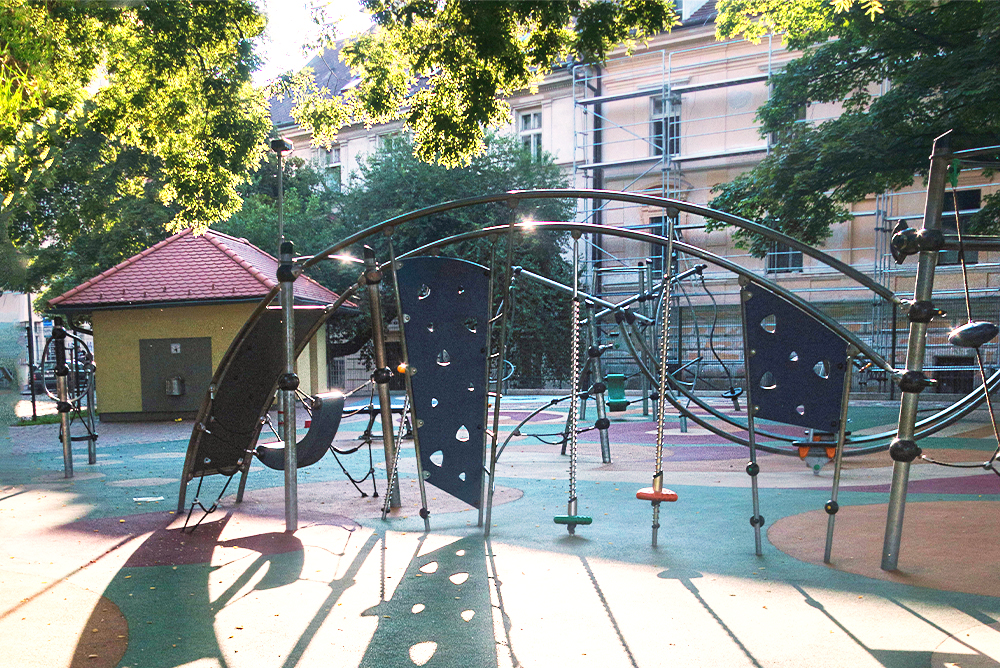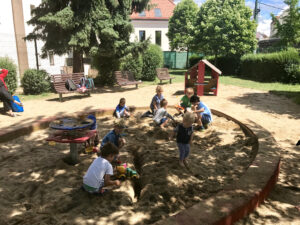
Neighborhood parks are crucial sites of creativity and socialization for children. But they are important for adults, too, historian Chad Bryant writes. Courtesy of Richard Tanton/Flickr (CC BY-NC 2.0).
In 2013, my wife and I rented an apartment in Výtoň, a classic urban neighborhood south of the tourist-packed city center of Prague. This wasn’t my first move to the capital of the Czech Republic. As a historian, I had been coming to Prague for short spells each summer for 10 years running. But, eager to explore, I always chose a different neighborhood to live in. My only fixed points were friends’ homes, a few locally admired pubs, and the archives that justified these trips to one of the world’s most beautiful cities.
Our Výtoň apartment was just a block from the banks of the Vltava River, where a farmer’s market appeared each Saturday morning. Locals promenaded along the quay in the evenings. The best gelato in town was steps away, as was a reliable grocery store and hip café. Up the hill was Vyšehrad, the city’s original fortifications-turned-massive park, which boasted panoramic views of the city. The neighborhood was a new adventure for me, as was this particular trip to Prague: it was my wife’s and my first time seeing the city from a parent’s-eye view. Before having a family, I had enjoyed the refreshing lonesomeness of being a foreigner. But now, we were seeking to help our kids feel at home as they navigated a different language and culture. Before long, it was Výtoň’s neighborhood playground that transformed the city into a home for all of us.
Filling half a city block, Výtoň’s playground had soft rubber flooring, a variety of color schemes, and a respectable sand pit. There was a large, spinnable ring whose purpose eluded nearly everyone. Run on it, like a treadmill, and then, inevitably, crash to the ground? Sit and let centrifugal forces fling you off? Knobby, oddly twisted climbing equipment complimented modernist-inspired see-saws and swings. Across the street, the occasional passenger train eased itself along an elevated railroad track. The sight never failed to excite my boys, then 5 and 3, who shouted giddily in Czech: Vlak! Vlak! (Train! Train!)
Playgrounds first emerged in the late 19th century, as part of a progressive effort to provide children in poorer neighborhoods with a dignified place to play. Other proponents argued that playgrounds kept kids out of trouble, providing a safe space from the evils and temptations of the big city. The precursors to the modern playground consisted solely of large sand pits where younger children sat and played with toys. By the turn of the century, swings and parallel bars, as well as space to sew or play games like baseball, were added in order to attract older kids to what became known as a “playground.”
Since then, safety concerns have partially driven further innovations in playground design, such as the move from concrete and steel to plastic and rubber. Gone are teeter ladders and high-in-the-air trapeze structures; instead, new, colorful structures that can be climbed, spun, and rocked mingle with old favorites, like sandpits and swings. These designs have been influenced by an emerging scholarly and political consensus that playgrounds, just like play, are crucial to childhood development. They foster language development and social skills. They move bodies and help with coordination. They allow children to enjoy the feeling of being temporarily free of overbearing rules and supervision.
Playgrounds are for parents, too. Whoever designed the Výtoň playground clearly had adults in mind, as the benches are numerous and comfortable. Taking a seat and keeping watch on my boys out of the corner of my eye, I treasured rare moments of peace as the Czech language of childhood—with its peculiar diminutives and sing-songy tones—filled the playground. Over time, I began to recognize other regulars who frequented the park. But we rarely spoke, unless we were forced to share the same bench—or if someone felt obliged to point out that my kid really should be wearing a winter hat in February. I was grateful for this ability to co-exist in silence, which gave my mind time to wander. Playgrounds, I learned, encourage imagination—and not just among children.
Often, as I sat on one of the playground’s plastic park benches, my daydreams fixated on the former customs house located just a few steps away. The name “Výtoň,” I soon learned, most likely emerged from the verb “to take a cut” (vytínat), referring to the duty levied upon goods traveling by boat to the city. Before the 20th century, Výtoň was one of Prague’s poorest neighborhoods. Many of its inhabitants earned a meager living pulling from the river timber that floated toward Prague from the south Bohemian forests. In the winter, many of these same inhabitants chopped ice from the river for the city’s pubs. They had children, too, yet we know almost nothing about these parents’ lives, or where their kids played.
Though I don’t know the exact date in which the Výtoň playground was built, looking at historical maps of the neighborhood, a green space first appears on the site of today’s playground in 1950. This tracks with the transformations that took place in Prague before Communists seized power: During the first half of the 20th century, grand, middle-class apartment buildings; state government offices; and houses that remain some of the city’s premier examples of cubist architecture replaced the neighborhood’s rickety structures and local prison.
Výtoň and other playgrounds that emerged as part of these urban renewal efforts speak to the progressive impulse to provide all children with a place to play. They are reminders that well-planned public spaces can create a sense of community and respite. Their absence, and decay, point to the ways that urban geographies magnify privilege and inequalities.
For my family and me, the most important effect of these plans and designs was the way that they created a sense of belonging. The playground became a place in which I could imagine myself playing a minor role in my story of its—our— neighborhood, a story told through brief neighborly encounters and soothing moments of solitude accompanied by the soundtrack of the city. It was there, daydreaming on a plastic green park bench and watching my kids play with their peers, that my foreignness faded and Prague started to become a home. In a way that no other place could, Výtoň’s playground welcomed us into the life of the city.





Send A Letter To the Editors